Buying Guide: Baby Teething Toys
Looking for suggestions to help your teething baby? Our buying guide to baby teething toys covers why using a baby teether can be helpful, signs that baby is teething, tips for using teethers safely, and our recommendations for baby teethers, including teething toys, rings, tubes, mittens, necklaces, and food-related teethers.
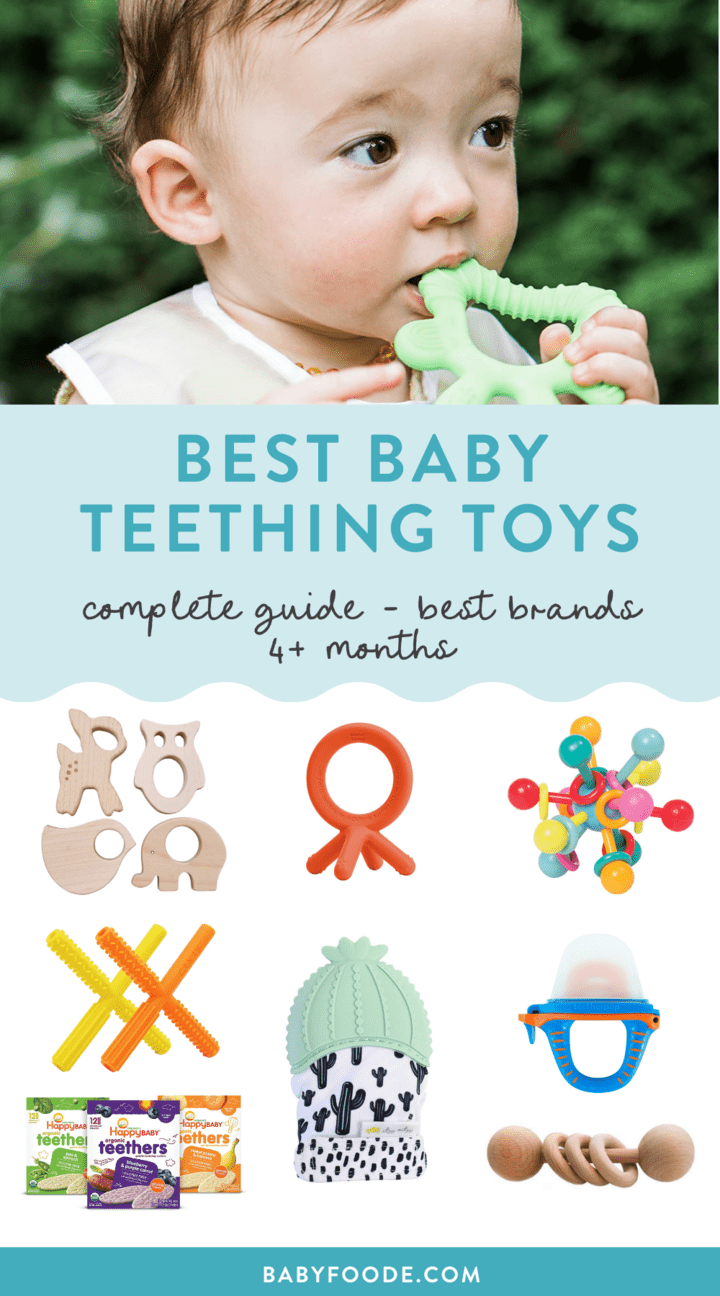
Medically reviewed and co-written by Lauren Braaten, Pediatric Occupational Therapist (OT).
Teething Toys for Baby
Around 4-6 months, most babies start teething. While teething is an exciting milestone, it can also be a bit painful at times (for both you and baby!). Over the span of about 2 and 1/2 to 3 years, twenty primary (baby) teeth will slowly emerge in your baby/toddler’s mouth.
Most babies will seem fussier and more irritable during teething, so it’s only natural as parents that we’d want to try and ease some of your baby’s aches and pains if possible. Teething toys are one helpful tool that gives your baby a safe and clean way to manage some of the misery that comes with sore and swollen gums due to teething. Chewing on teething toys provides counter-pressure against the tooth that’s erupting.
Why Use a Baby Teether
- Alleviates pain and discomfort from teething
- Provides a safe and developmentally appropriate way for baby to explore their world
- Helps with the development of strength in the jaw, tongue and cheeks necessary for eating
- Improves sensory awareness
- Assists with desensitizing the gag reflex, which helps baby handle a variety of foods for chewing and swallowing
- May help with accepting a wider range of textures of food when it’s time to start solids
Signs your Baby is Teething
Every baby (and every tooth, for that matter) is different – so keep in mind that your baby may go through periods where teething seems to bother them more or less than others. The following can be signs that your baby is teething:
- Increased drooling
- Increased chewing on fingers or toys
- Mood changes
- Irritability or fussing
- Swollen gums
- Sleeplessness or restless sleep at night
- Mild fever
- Refusing to eat or drink due to pain
What to Look for in a Teethers
There are a variety of shapes, sizes, and materials available when considering a teething toy. Circular or ring-shaped teethers are great as they allow for your baby to grasp with one or both hands easily. Stick-shaped or toothbrush-type teethers can be helpful for older babies and toddlers that already have some experience with moving a teether around in their mouth and have worked on desensitizing their gag reflex.
Materials used could include silicone, natural wood (such as beech wood) rubber, or cloth. Many common teethers are made of food-grade silicone and BPA-free, making them easy to clean and durable. Teething toys that offer a variety of textures, such as bumps or gentle ridges, can help massage and soothe gums.
Frequently Asked Questions
Teething toys help your baby be in control of easing discomfort, but it doesn’t mean they are absolutely necessary. Homemade teethers, such as a cool wet washcloth or even counter pressure from your finger can also be used on your baby’s gums.
Teethers come in all shapes, sizes, materials and textures, so selecting the best teether will be specific to your baby. However, having at least 3 different teethers to rotate through can be helpful when baby’s preferences change from time to time.
You can start introducing teethers to your baby around 4-6 months, which is about the time that most babies begin teething. Even older toddlers can benefit from using a teether occasionally, as the molars start to erupt.
Teething Safety
- Use supervision – we don’t recommend leaving any teether in your baby’s crib during naps or overnight.
- Inspect regularly – even the sturdiest of teething toys may start to show some wear and tear, given enough time and depending on your baby’s chewing habits.
- Clean often – and read instructions for cleaning. Some teethers can be sterilized in boiling water, but some may be handwash or wipe only.
- Think cool, not frozen – a teething toy that’s too cold may damage sensitive gums. Place in the fridge instead or only in the freezer until just cold (likely 10-15 minutes) if you are wanting to give some cooling relief.
Tips on How to Use a Baby Teething Toy
- Consider investing in a few different teething toys to rotate through, as what seems to help or interest your baby one week may be different the next.
- Offer a teether for a few minutes before meals when your baby is sitting in their highchair. Getting some chewing practice and sensory input before eating can be a perfect time to use a teether.
- Older babies and toddlers may like dipping a stick shaped teether in a cool puree for some added relief to their gums.
- If your baby doesn’t seem interested in using a teether right away, model bringing the teether to your own mouth and see if they will imitate you.
Homemade Teethers for Baby
There are lots of great options for homemade teethers as well. Some ideas for babies to chew and mouth include: a wet, cool washcloth, a spoon placed in the fridge for a couple hours until cooled or refrigerating a plain bagel. You can also give a cloth teether some added texture by tying knots or braiding fabric from clean, recycled clothing. Just keep the same tips in mind for teething safety as discussed above, no matter which type of teething toy your baby prefers.
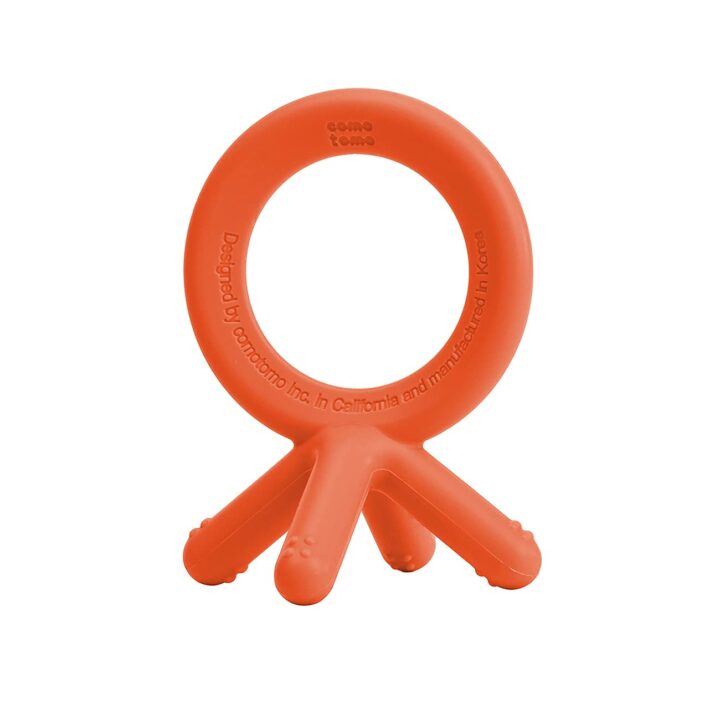
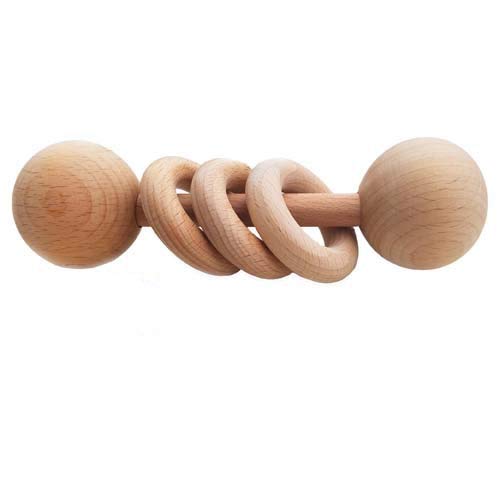

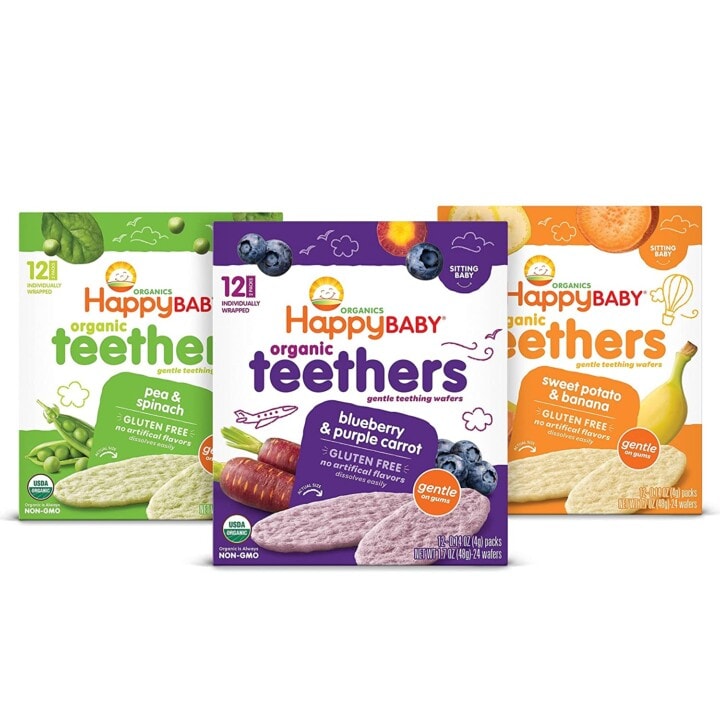

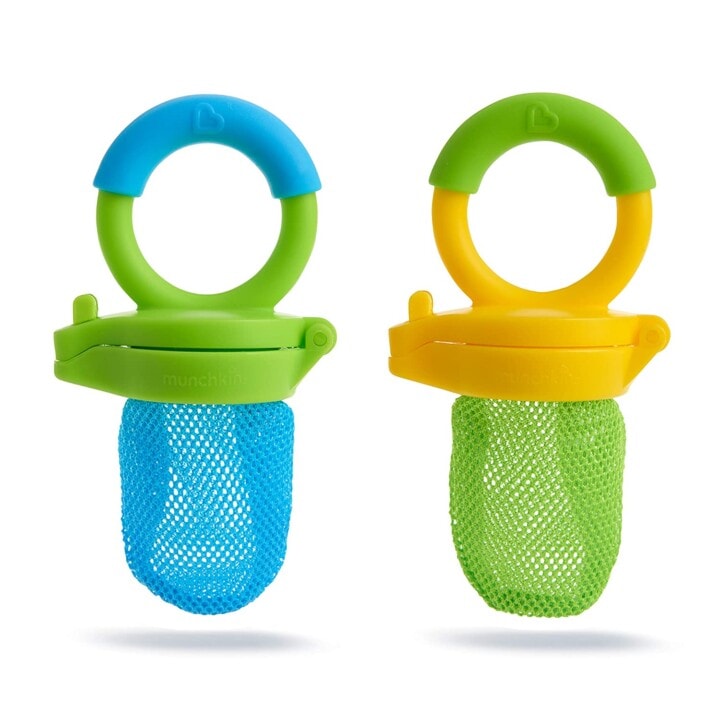
Different Types of Teethers for Baby
With so many types of teethers available, we’ll discuss a few of our favorite teething toys, specifically teething rings, mittens, tubes, biscuits, and necklaces. Having a few options for your baby to choose from can help ease those teething troubles.
Teething Toys: come in a variety of fun shapes, textures, colors, and patterns to interest your baby and encourage some relief for sore and swollen gums. Teething toys also provide opportunities for developmental play, as your baby works on grasping, hand-eye coordination, and sensory exploration.
Teething Rings: are basically just teethers with a circular design. They can be made from a variety of materials, including silicone, wood, rubber, or cloth. Teething rings can be helpful for beginning teethers because they are easy to grasp with both hands and cover a lot of surface area at the front of the mouth where your baby’s first teeth erupt.
Teething Tubes: are usually longer, hollow, and flexibly designed teethers that allow for your baby to place the tube farther back in the mouth, on the molar surfaces. Teething tubes can be helpful for older babies and toddlers that already have some experience with moving a teether around in their mouth and have worked on desensitizing their gag reflex.
Teething Mittens: gives your baby a safe surface to chew on and relieve aches from teething. Teething mitts are usually made of a combination of textured silicone and cloth. Teething mittens can be a good option if your baby seems to be using their fingers for teething a little TOO much (to the point where the skin might be red or breaking down). These types of teethers can also be helpful for a baby who still frequently drops teething toys and gets frustrated by this because you can fasten the mitt to stay on your baby’s hand.
Teething Necklaces: are typically made of amber, wood, or silicone. Some are designed for your baby to wear, while others are made for a caregiver to wear (and baby can use the teether while being held). Advocates of teething necklaces, especially those made of amber, believe that chewing on the beads releases succinic acid, a natural painkiller.
Wooden Teethers: Many parents choose wooden teethers due to wood’s natural antibacterial and antimicrobial properties. Wooden teethers are often finished with oils or beeswax to seal the wood, which protects from damage and splinters. These types of teethers can be cleaned by wiping with a damp cloth or using fine-grit sandpaper to brush away any dirt or damage on the wood’s surface.
Food Teethers: are usually a mesh or silicone pouch with lots of little holes for your baby to teethe on foods placed inside. Most food teethers also have some type of handle so your baby can easily grasp and bring them to their mouth. Filling the food teether with frozen fruit can be a great way to relieve sore gums in babies and toddlers.
Teething Biscuits: If your baby is already taking solid foods, you can also consider offering teething biscuits to help alleviate discomfort. Teething biscuits are easily dissolvable soft solids that your baby can mouth and chew on, without crumbling or cracking. Just don’t fall into a habit of offering them frequently as a teething option, as teething biscuits typically have limited nutritional value for growing babies and toddlers.

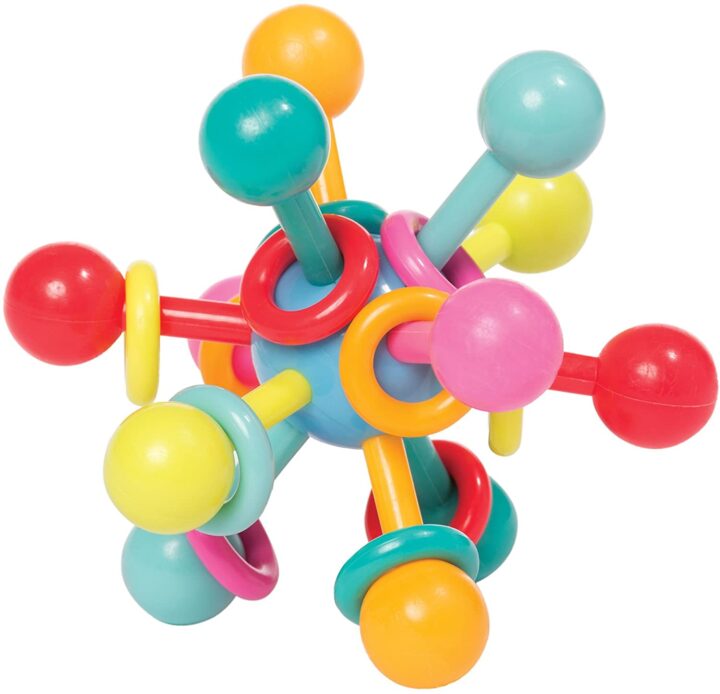

Teething Toys
Teething toys come in a variety of fun shapes, textures, colors, and patterns to interest your baby and encourage some relief for sore and swollen gums. Teething toys also provide opportunities for developmental play, as your baby works on grasping, hand-eye coordination, and sensory exploration.
Best Baby Teething Toys
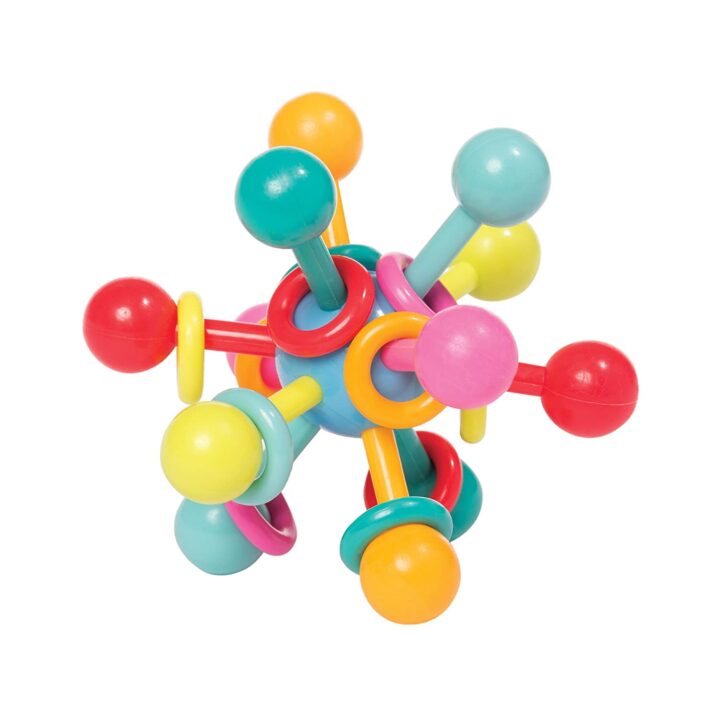
Manhattan Toy Winkel Rattle & Sensory Teether Toy
This teether toy features a mesmerizing maze of soft, continuous BPA-free teething tubes. It can be refrigerated for additional soothing comfort – a perfect baby chew toy for tiny hands.
- Colorful and lightweight
- Continuous loop design makes it easy for little hands to grasp and hold
- The center cube has tapered corners and a gentle rattle to provide auditory stimuli
- The soft, pliable teething loops are perfect for teething or gumming babies

Comotomo Silicone Baby Teether
This perfectly sized teether has an intuitive design that makes it easy for baby to grab and hold.
- Made with durable, high quality, food grade silicone
- Simple one-piece design makes it easy to clean
- Textured bumps on the ends provide added sensory input

green sprouts Front & Side Teether
This Green Sprouts teether is made from soft, flexible silicone. Multiple textures and surfaces massage front and side gums during different stages of teething.
- BPA- and PVC-free silicone
- Perfectly sized for baby’s hands
- Durable and easy to clean

Nuby Silicone Teethe-eez Teether
This firm, yet flexible teether is made of 100% silicone. Multiple teething surfaces aid in the eruption of new teeth.
- Fish-shaped design fits perfectly in little hands and teething surfaces.
- Includes hygienic carrying case to keep teether clean when not in use
- BPA Free
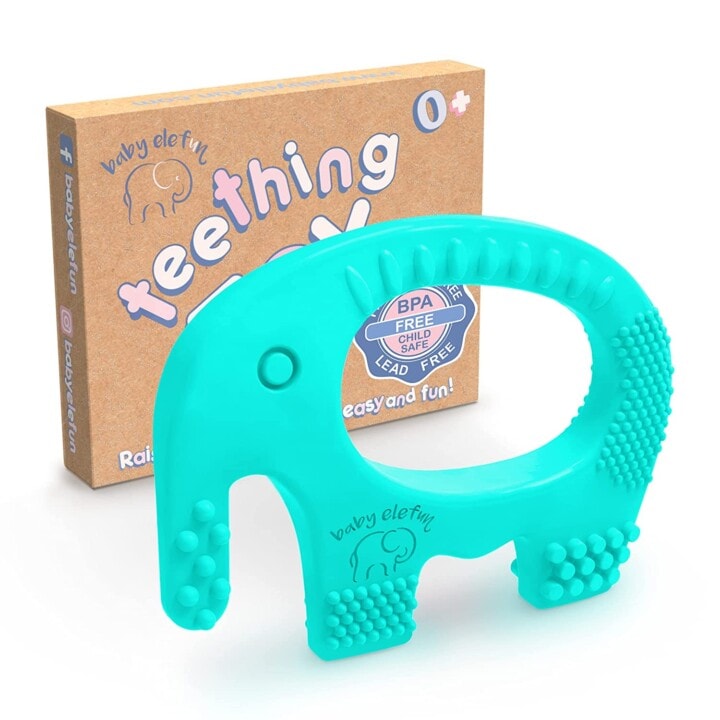

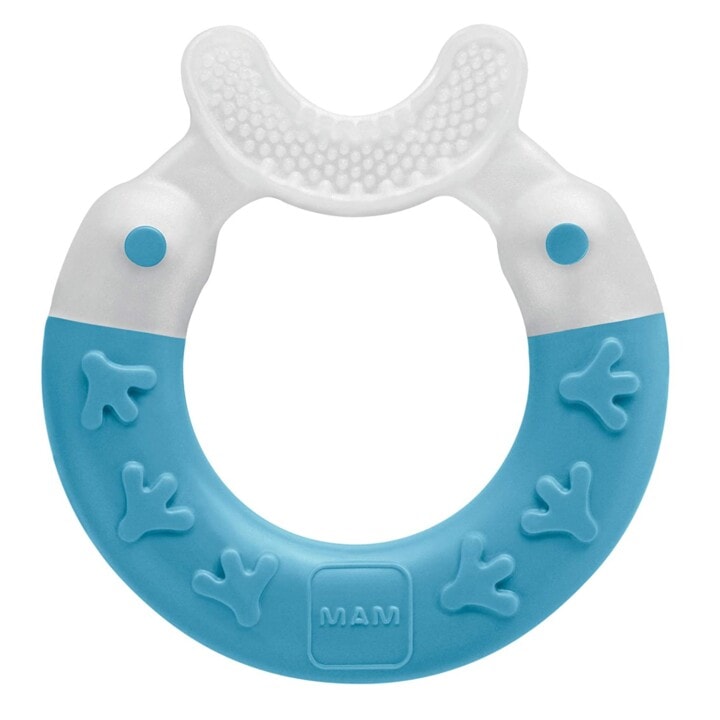
Teething Ring
Teething rings are basically just teethers with a circular design. They can be made from a variety of materials, including silicone, wood, rubber of cloth. Teething rings can be helpful for beginning teethers because they are easy to grasp with both hands and cover a lot of surface area at the front of the mouth where baby’s first teeth erupt.
Best Baby Teething Rings
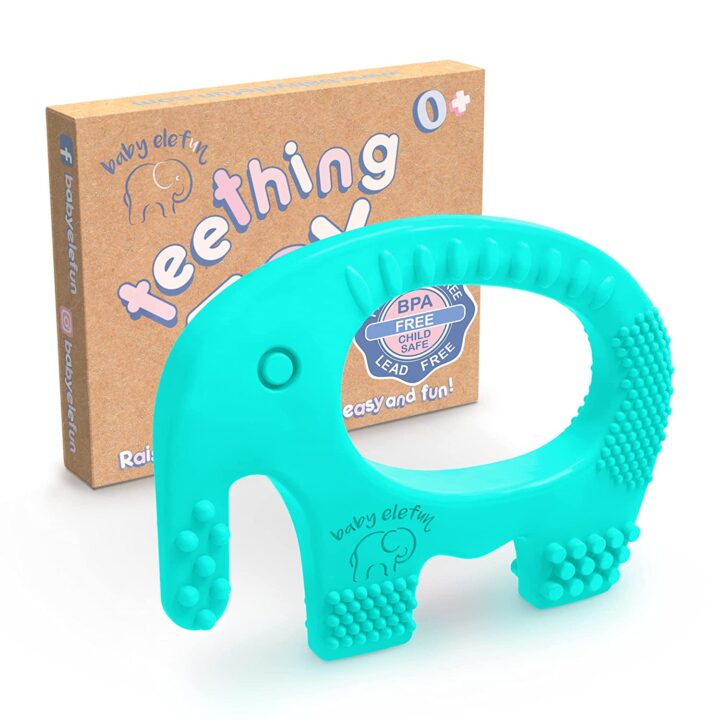
Baby Elefun Teething Toy
This cute elephant teether has 5 different textures and bristles to stimulate gums. The innovative design helps baby reach the molars as well.
- 100% Food Grade Teething Silicone
- Hollow design and textures provide an easy to grip teether
- Cleaning options include dishwasher-safe, sanitize in boiling water, UV steam sterilizer, or simply hand wash.
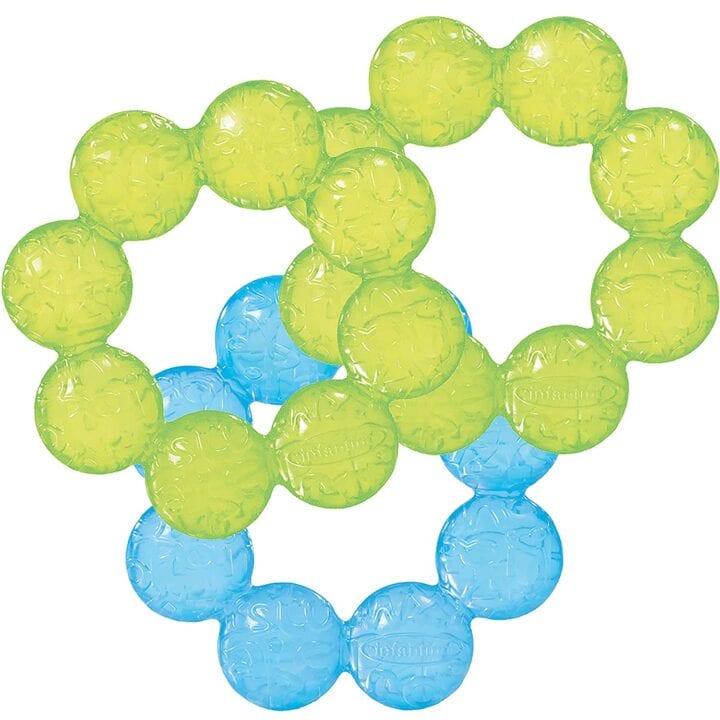
Infantino Water Teethers
These teethers are a great deal for a 3 pack! Soft, textured teether helps soothe gums and can be chilled in the fridge for cool comfort.
- Circular design is easy for small hands to grasp and hold
- Filled with distilled water
- Hand wash only – not dishwasher safe
- Slightly larger and thicker compared to some teethers, so may be best for babies 8-9+ months
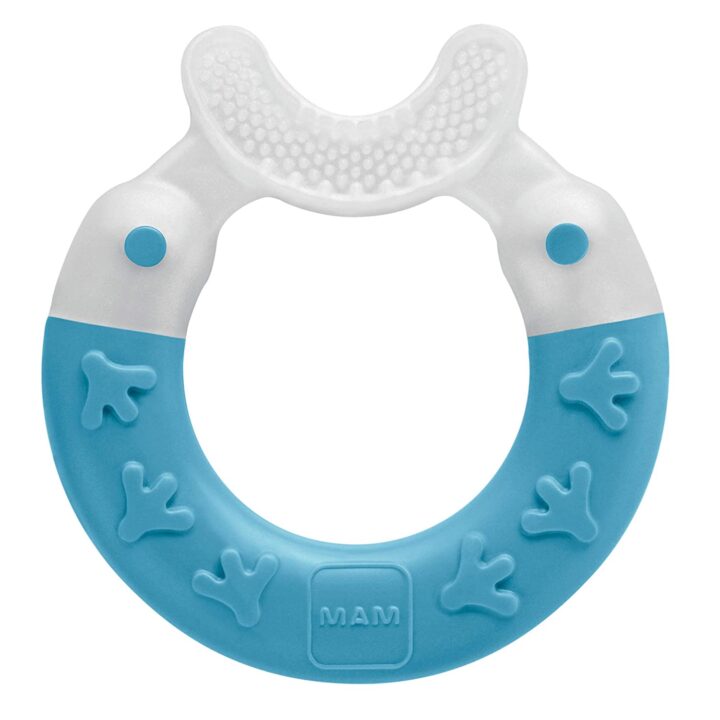
MAM Bite and Brush Teether
The MAM Bite and Brush teether helps massage sore gums while gently cleaning baby’s first teeth. The variety of textures make for a fun and engaging teether.
- Made from high quality silicone, 100% baby safe, BPA & BPS-free materials
- Helps develop baby’s sense of touch and strengthens oral muscles
- Easy to clean and sterilize


Teething Tubes
Teething tubes are usually longer, hollow, and flexibly designed teethers that allow for your baby to place the tube farther back in the mouth, on the molar surfaces. Teething tubes can be helpful for older babies and toddlers that already have some experience with moving a teether around in their mouth and have worked on desensitizing their gag reflex.
Best Baby Teething Tubes

Teething Tube with Safety Shield
This pair of teething tubes comes with a removeable and adjustable safety shields. The safety shields ensure that the teether stays at a safe distance from baby’s throat.
- Made of 100% premium food-grade silicone, non-toxic, and free of Latex, Phthalate, and Lead
- Multiple textures on each side of the hollow teething tube provide a great sensory experience
- Dishwasher (top rack) and steam sterilizer safe, can also boil in hot water
- Comes with cleaning brushes for the internal part
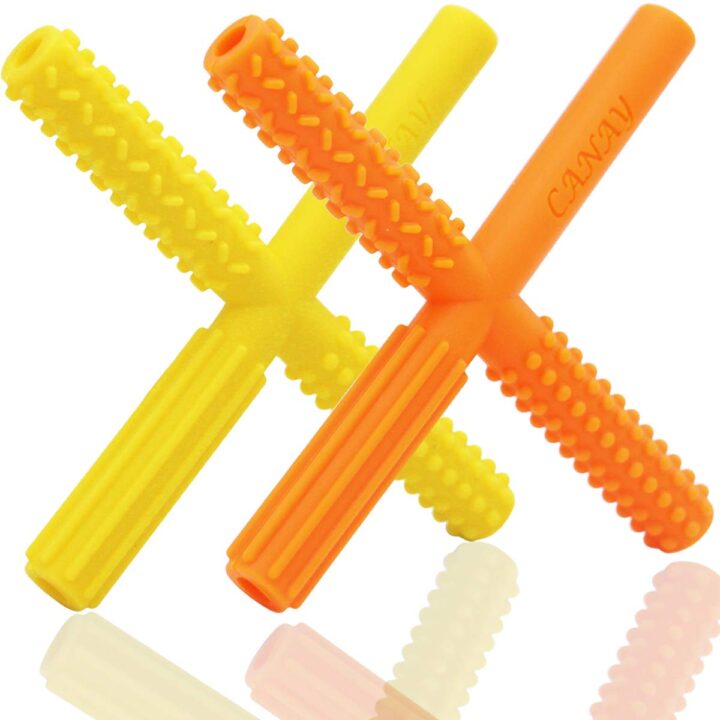
X Hollow Teether Tubes
The X shaped design of these teething tubes provides a flexible yet firm shape for baby to grasp and chew.
- Different textures on all sides provide a variety of chewing surfaces
- Made of 100% food grade silicone
- BPA, PVC, Lead, and Phthalates free
- Safe for dishwasher or handwash cleaning
Teething Mitt
A teething mitt or mitten gives your baby a safe surface to chew on and relieve aches from teething. Teething mitts are usually made of a combination of textured silicone and cloth. Teething mittens can be a good option if your baby seems to be using their fingers for teething a little TOO much (to the point where the skin might be red or breaking down). These types of teethers can also be helpful for a baby who still frequently drops teething toys and gets frustrated by this because you can fasten the mitt to stay on your baby’s hand.
Best Baby Teething Mittens

Itzy Ritzy Silicone Teething Mitt
This teething mitt comes in a variety of fun patterns and textures to help provide relief to emerging teeth and massage sore gums.
- Made of food grade silicone, non-toxic and free of BPA and PVC
- Teething mitt also includes a crinkle sound that stimulates baby and keeps them entertained
- An adjustable strap ensures a secure fit and helps the mitt stay in place – perfect for babies who can’t yet hold a teether!
- Teething mitts are machine washable, machine wash on cold or hand wash and air dry

Infantino Crystal Clear Teething Mitten
This cute mitten has teething ears designed to easily and safely satisfy must-get-there teething space for baby.
- Teething surface is free from BPA, PVC, dyes and phthalates material
- Different textures and materials provide sensory stimulation and support development
- For washing, simply pull the fabric part away from silicone teether for easy and complete cleaning
Teething Necklaces
Teething necklaces are typically made of amber, wood, or silicone. Some are designed for your baby to wear, while others are made for a caregiver to wear (and baby can use the teether while being held). Advocates of teething necklaces, especially those made of amber, believe that chewing on the beads releases succinic acid, a natural painkiller.
Please note that research studies have not supported these claims. In addition, the American Academy of Pediatrics does not recommend that infants wear any jewelry. If you choose to use teething necklaces, please use extreme caution. Always supervise when your baby is wearing them and remove the necklace when your baby is sleeping or unattended, even if for a short period of time.
Best Baby Teething Necklaces
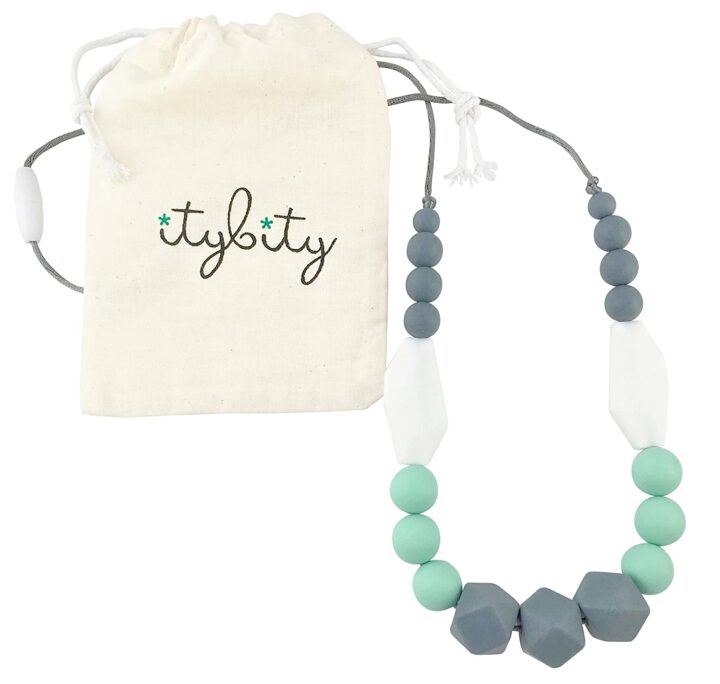
The Original Baby Teething Necklace
This teething necklace is designed to be worn by a caregiver to provide baby teething relief while being held.
- Made of food-grade silicone, BPA free, no phthalates, cadmium, lead or metals
- Dishwasher safe
- Lifetime warranty
- Parents have commented that it works well to keep baby from scratching or pinching during breastfeeding
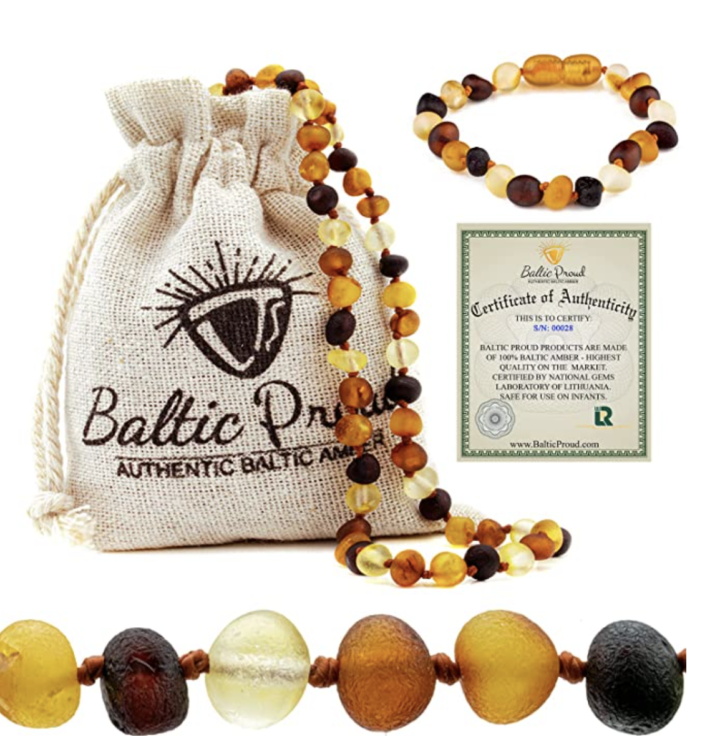
Raw Baltic Amber Necklace and Bracelet Set
This teething necklace and bracelet set is made with a plastic screw clasp and every bead is knotted separately to prevent scattering.
- Comes directly from Baltic Sea country, Lithuania – the heart of amber origin
- Lab tested by the International Amber Association
- Includes a 1-year risk free, money back guarantee
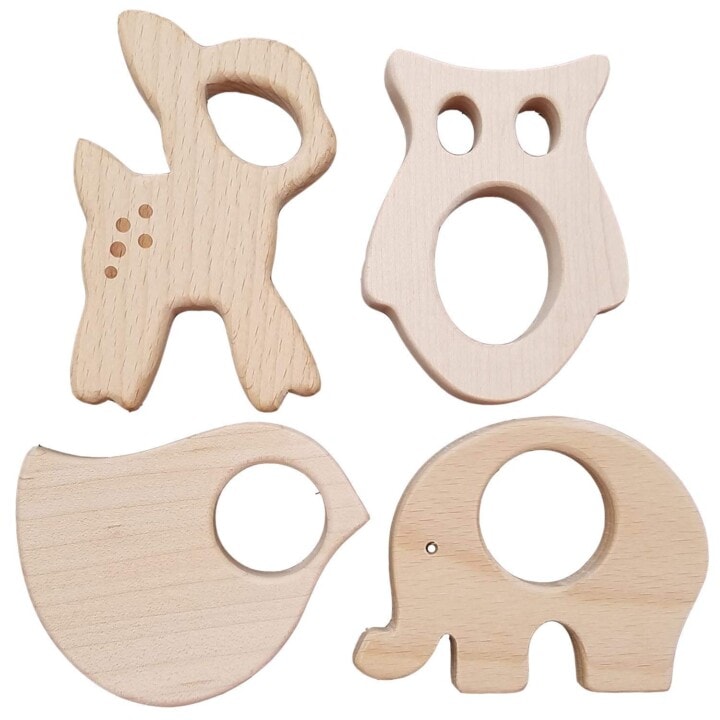

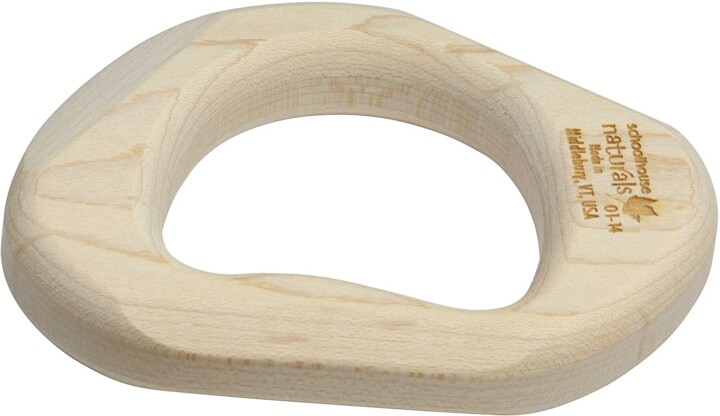
Wooden Teethers
Many parents choose wooden teethers due to wood’s natural antibacterial and antimicrobial properties. Wooden teethers are often finished with oils or beeswax to seal the wood, which protects from damage and splinters. These types of teethers can be cleaned by wiping with a damp cloth or using fine-grit sandpaper to brush away any dirt or damage on the wood’s surface.
Best Wooden Teethers

Crochet Bunny Teething Ring
This adorable set includes one small and one large teether made from natural untreated beech wood and cotton. These are a great ecofriendly option for teething toys.
- Perfectly sized for little hands to grasp
- Phthalate-free, Latex Free, Lead-Free, BPA Free, and hand-sanded to perfection
- Gender-neutral colors
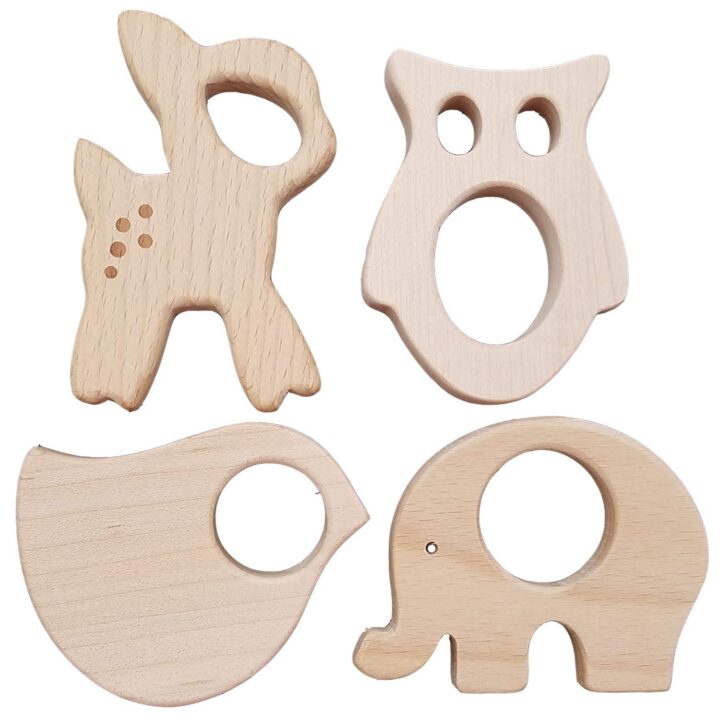
Natural Wooden Baby Teether Toys
This set of forest animal wooden teethers is a great buy. You’ll always have a back-up teether with this 4-pack of teething toys.
- Cut from solid Maple wood. No glues or sealants ever used.
- Easy to clean
- Cute patterns are sized just right for baby’s hands
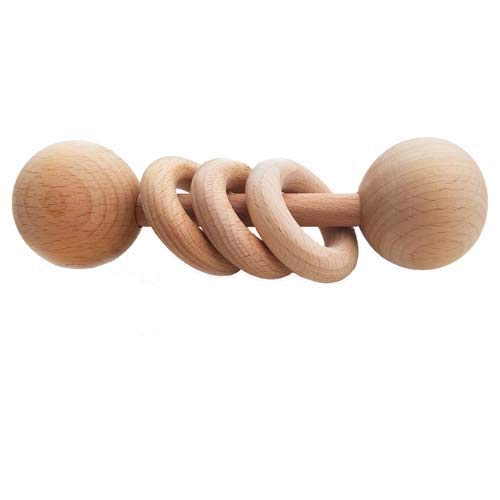
Baby Wooden Toy Rattle and Teether
This wooden rattle and teether is made from solid beech wood and sanded to a smooth finish.
- Phthalate-free, Latex Free, Lead-Free, BPA Free
- Great size for teething gums and easily fits into baby’s hands
- Could also be used as a cute newborn photo prop or milestone photos
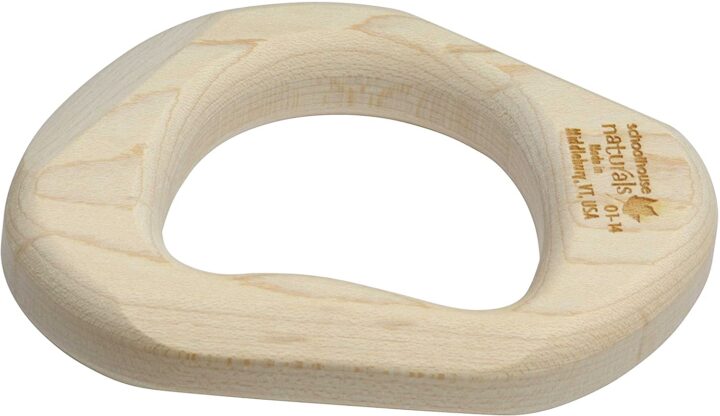
Maple Teether
This minimalist wooden teether is sanded smooth to the touch and a high-quality, no-fuss option for teething.
- Cut from solid hardwood Maple
- Simple ring design makes it easy for even young babies to hold
- To clean, simply wipe with a damp cloth or mild soap
Food Teethers
Baby food teethers are usually a mesh or silicone pouch with lots of little holes for your baby to teethe on foods placed inside. Most food teethers also have some type of handle so your baby can easily grasp and bring them to their mouth. Filling the food teether with frozen fruit can be a great way to relieve sore gums in babies and toddlers.
Best Food Teethers

Munchkin Fresh Food Feeder
With its simple mesh design, this teething feeder allows for babies to gnaw on foods safely. Baby can chew, suck and taste foods with only small, digestible pieces coming through – reducing the risk of choking.
- Simple and easy to use, snaps shut to secure
- Colored mesh reduces staining
- BPA free
- For ages 6+ months
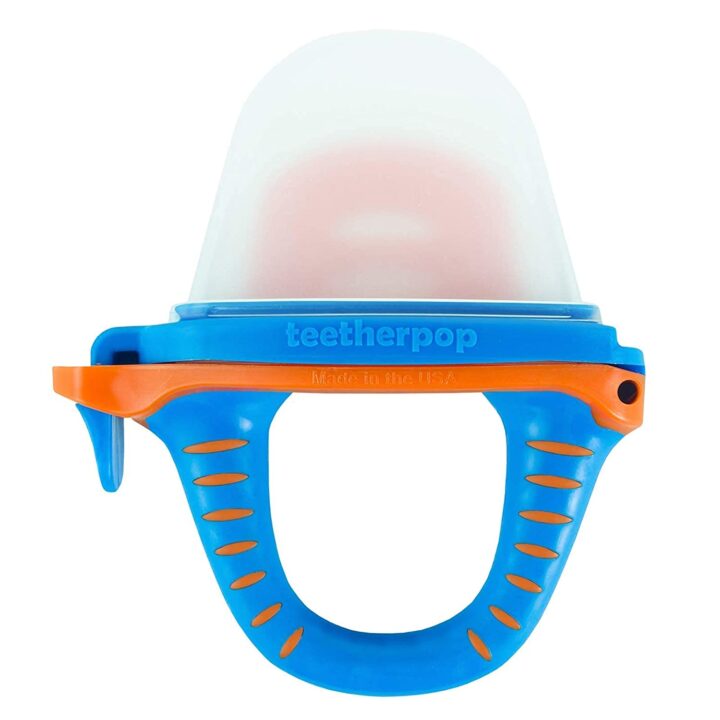
Teetherpop Teething Toy
The Teetherpop has flexible silicone slits to allow the flow of your baby’s treat and keep the contents contained for less mess. It can be filled with purees, water, breastmilk, homemade smoothies or juices.
- Freezable for an added treat
- Made from medical grade materials and is free from BPA, PVC, phthalate and latex
- Dishwasher safe
- For ages 6+ Months

Haakaa Baby Food Feeder and Teether
The Haakaa baby fruit feeder doubles as a teething toy. Its handle is designed as a silicone teether, with raised ridges and bristles on the rabbit’s ears to massage baby’s teeth and gums.
- Patent Milk Freezing Design allows breastmilk or other liquid to be poured directly into the feeder without leaking and put in the freezer to get frozen milk and cooling teething relief
- Made from 100% food-grade silicone and BPA free
- Dishwasher safe and easy to clean
Teething Biscuits
If your baby is already taking solid foods, you can also consider offering teething biscuits to help alleviate discomfort. Teething biscuits are easily dissolvable soft solids that your baby can mouth and chew on, without crumbling or cracking. Just don’t fall into a habit of offering them frequently as a teething option, as teething biscuits typically have limited nutritional value for growing babies and toddlers.
Best Baby Teething Biscuits
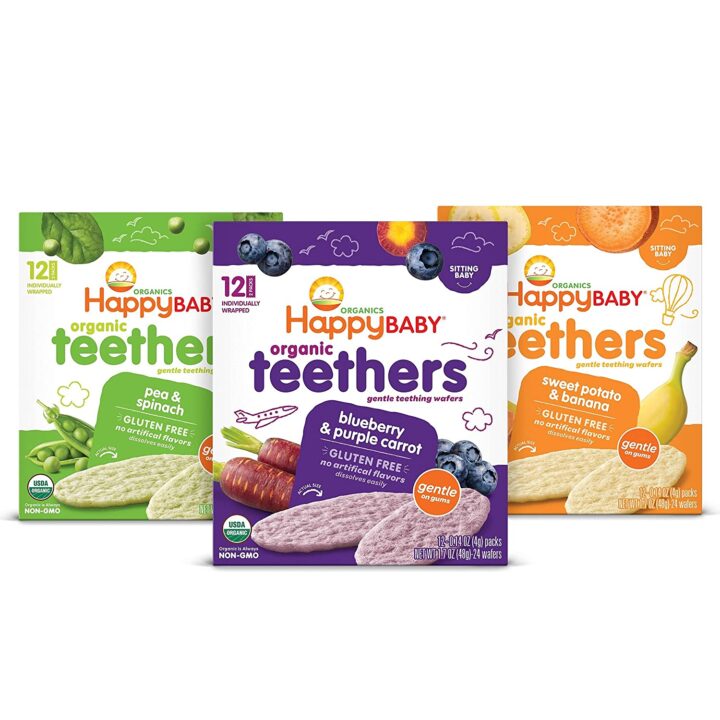
Happy Baby Organic Teethers
These Happy Baby Organic Teethers come in a variety pack and are made with jasmine rice flour and a touch of organic fruits and vegetables.
- Certified USDA organic, made with non-GMO ingredients grown without the use of persistent toxic pesticides
- Packaging free of BPA, BPS, or phthalates
- For babies that are sitting, typically ages 6+ months
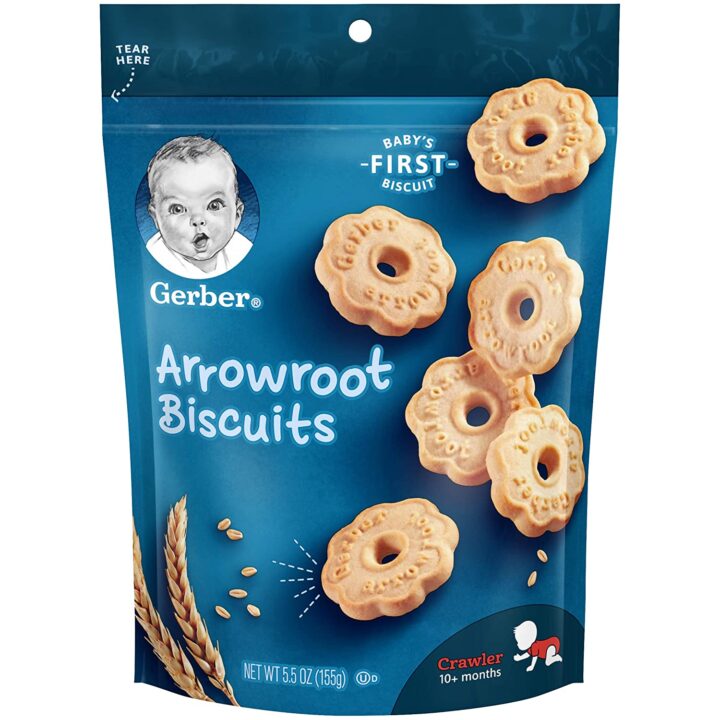
Gerber Arrowroot Cookies
These arrowroot cookies are perfectly sized for your baby’s hands and mouth. They are designed to soften quickly and are easily mashed with or without teeth.
- Recommended for babies that are crawling, typically ages 10+ months
- Contain 4 essential vitamins and minerals
- No artificial flavors or sweeteners, and no high fructose corn syrup
